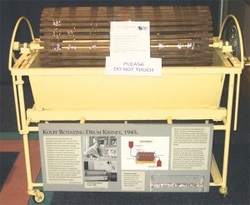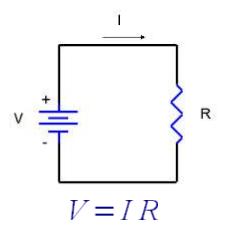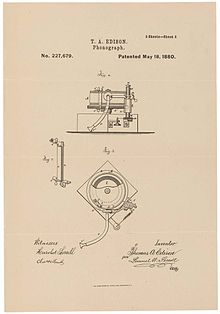|
'Inventors' is a series of portrait videos chronicling the work of contemporary inventors from all walks of life. In this video Ralph Baer, the father of video games, talks about those early days of video game history and why now, at 90 years old, he's still inventing. To see his patent click here.
0 Comments
A video of Dr. Francis Gurry, Director General of World Intellectual Property Organization (WIPO), speaking at Melbourne Law School. This lecture explored the major economic, social, and political developments affecting intellectual property. It also examined how innovation and intellectual property are increasingly central to economic strategy and competitive advantage, and showed how the knowledge economy is causing an adjustment to the way in which we think of the role of intellectual property. This USPTO video provides a quick and easy breakdown of the three main types of intellectual property: trademarks, patents, and copyrights. You’ll learn how trademarks differ from domain names and business names. By the end of the video, you’ll understand how to use each type of intellectual property to protect a different aspect of your business.  The Patent Resources Group is a provider of courses and publications in all aspects of patent practice and will be kicking off their annual advanced courses program in Florida on April 10 - 16. They will be having a number of really interesting offerings and I am currently interested in "Art & Science of Patent Searching". Check out all of the courses by clicking on their logo.  This month, March, has been National Kidney Month. The purpose of National Kidney Month is to raise awareness about various forms of kidney disease that affect one in every 10 adults in the United States a number likely to rise due to bad dietary and lifestyle choices. Once the kidneys fail to function there are only two choices available - death or treatment by a dialysis machine. The kidney dialysis is the invention of a remarkable man -- Dr. Willem Kolff. Kolff is a Dutch physician born in 1911. One of his first patients was a 22 year old man who died of kidney failure. The death made an impact on Kolff and he began studying how to replace kidney function artificially. Just as Kolff’s research began to yield results World War 2 started. As a result Kolff found it difficult to find the parts he needed for his artificial kidney and his first machine was built from sausage casings, beverage cans, a washing machine, and anything else he could get his hands on in 1943. Although initially his machine was not effective he kept improving it and in 1945 a 67-year-old comatose woman was treated and she regained consciousness following 11 hours of hemodialysis with his machine dialyzer. Eventually she was discharged and lived lived for another seven years before dying from an unrelated condition. In spite of the success of his machine Kolff never applied for a patent on his invention and never received any royalties on his remarkable machine that saved the lives of countless individuals.  Happy Birthday goes out today to Georg Ohm who was born in 1789. You may well wonder what significance Georg Ohm had in science but ask any Electrical Engineer as they used the law that bears his name in every class on circuit design from their freshman year until they graduate. Ohm's Law holds that the flow of electrical current through a conductor is directly proportional to the electrical potential. His name is also used as a unit of resistance. Georg was born in Germany and both of his parents lacked formal education. However his father, a locksmith, had educated himself in math, physics, and chemistry and taught those subject to Georg Ohm. At the age of 17 Georg Ohm began to teach mathematics at a high school. He wanted to advance his study of mathematics by attending university but was discouraged from doing so by his advisor who recommended that he start of program of self study. For the next four years Georg Ohm studied on his own and when when finally started his formal studies he was able to receive a degree in mathematics in just one year! After graduation he worked at various schools until he received a teaching position at a Jesuit school at the age of 28. There he began his experiments in electricity and at the age of 38 published his theory of electricity that became known as “Ohm’s Law”. At first his publication was heavily criticized as his approach of using experiments to establish scientific principles, now widely accepted, was considered nonconformist. Georg Ohm passed away at the age of 65. During his life he published papers and books in the fields of electricity, physics, and mathematics and obtained memberships in the highly regarded Royal Society and the Bavarian Academy of Sciences and Humanities. Although he passed away over 150 years ago his law is still taught to tens of thousands of engineering students around the world each year.  Today in IP: On this day in 1900 patent #644,077 was issued to Felix Hoffmann for perhaps the most widely used over the counter medication used today - aspirin. How widely used is aspirin? It is estimated that over 100 billion tablets are manufactured each year, plenty for each person living today. Although Felix Hoffmann was a brilliant chemist, graduating magna cum laude at each academic level, the useful properties of the active ingredient of aspirin, salicylic acid, was already known. In fact Hippocrates (440-377 B.C.) was known to prescribed the bark and leaves of the willow tree, rich in salicylic acid, to reduce pain and fever. However during the Middle Ages the usefulness of the willow tree was forgotten and replaced by more modern methods such as leeches. About 1760 a clergyman by the name of Edward Stone came onto the scene. He suffered from a variety of sickness such as fevers and aches in his joints. For some unknown reason he found that he could get relief by chewing the bark of a willow tree. He then conducted experiments on others and found that they also experienced similar benefits. Yet in spite of the benefits only a few people could handle the stomach irritation from the salicylic acid. It remained that way for 140 years until Felix Hoffmann arrived. Felix Hoffmann synthesized a version of salicylic acid that did not irritate the stomach. That synthesized version became known as aspirin.  Birthday in IP: Today in 1955, Steve Paul Jobs, was born in San Francisco, California. This iconic innovator has his name on 346 patents (mostly design patents), has created markets where none existed, co-founded Apple and Pixar, and his actions would even change the course of his competitors. I was an electrical engineering student during the late 70s/early 80s and experienced the steady progression of computers released by Apple during those formative years. When Steve Jobs resigned from Apple in 1985 after losing a power struggle over the control of Apple he started Pixar and NeXT Computer. Pixar was a group within Lucasfilm that Steve Jobs purchased for $10 million in 1986. The films produced by Pixar have become household favorites such as Toy Story, Monsters Inc., Cars, and many more. Steve Jobs later sold Pixar to Walt Disney for a stock transaction valued at $7.4 billion. Although NeXT Computers released novel and advanced computers sales were limited by their high cost and NeXT Computer never achieved much success. Apple, experiencing financial hardships, bought NeXT Computers in 1996 and brought Steve Jobs back into a leadership role. The results since then have been nothing short of spectacular as Apple released a string of successful and innovative products. Steve Jobs died October 5, 2011. He was 56 years old.  Today in IP: On this day in 1865 patent #46,454 was issued to John Deere for advances he made to the plow that significantly contributed to the growth of the United States. You may be wondering how can a simple tool like a plow make such an impact. Well to get that answer you have to go back to 1803 when President Thomas Jefferson made the Louisiana Purchase. Much of the land in this purchase included the Great Plains states where the flat land was ideal for farming but for the soil. The soil in the Great Plains states were wetter and more clay like than the soil in the eastern states. As a result Great Plains farmers had a difficult time plowing their lands as every few feet the sticky soil clinging to their plows would have to cleaned. This hardship discouraged people from moving westward to start farms of their own and the lack of settlements in the Great Plains area made travel to western states such as California challenging. John Deere, a blacksmith, came to the Great Plains in 1836 and learned of the problem farmers were having plowing their land. Mr. Deere soon set about redesigning the plow so that the soil would not stick and a year later, 1837, he began to sell his plow to local farmers who quickly spread the word. Less than 20 years later Mr. Deere was selling over 13,000 plows a year and his plow became known as “The Plow that Broke the Plains" as many farmers moved to the Great Plains to take advantage of government land grants. Following the farmers came the settlements and the transportation infrastructure to support it. Without Mr. Deere’s plow westward expansion would have been much slower. Mr. Deere died a millionaire in 1886 but his legacy lives on in the company he started, Deere & Company, whose green and gold farming equipment are a common sight on the land his plow once ruled.  Today in IP: On this day in 1878 patent #200,521 was issued to Thomas Edison for the phonograph. While Mr. Edison is best known for his advances in the light bulb they were just that, advances. Light bulbs already existed before Edison's although it was Edison's bulb that made them viable. In contrast, the phonograph was totally new. It was the first device that was able to record and playback sound. Before Edison's phonograph was invented people could not listen to music or a story unless they were physically present. Once Edison's phonograph became available people were amazed that they were able to listen to musical recordings that was performed earlier in time and in locations they had never been to. The science used for the phonograph continued to be widely used, with improvements, for over 100 years until the arrival of the compact disk (CD). So the next time you visit an antique museum see if you can find the phonograph and ask that it be played. Then try to imagine how you would feel if you were experiencing this for the first time. Truly for the people in Edison's day such a moment would be magical. If you enjoyed this fact please like it or +1 it on my social sites. |
Categories
All
|
California, Inland Empire - (909) 566-2801
California, Santa Barbara - (805) 500-6241
Tennessee - (423) 226-8036
Georgia - (404) 436-0899
California, Santa Barbara - (805) 500-6241
Tennessee - (423) 226-8036
Georgia - (404) 436-0899

